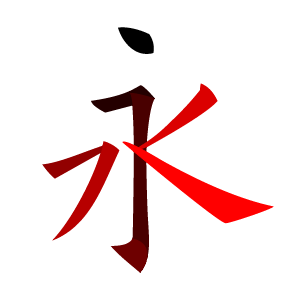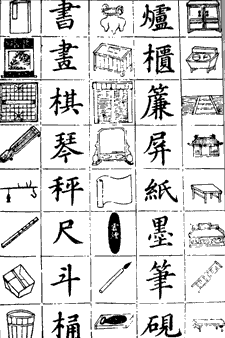|
Chinese Character Strokes
Strokes () are the smallest structural units making up written Chinese characters. In the act of writing, a stroke is defined as a movement of a writing instrument on a writing material surface, or the trace left on the surface from a discrete application of the writing implement. The modern sense of discretized strokes first came into being with the clerical script during the Han dynasty. In the regular script that emerged during the Tang dynasty—the most recent major style, highly studied for its aesthetics in East Asian calligraphy—individual strokes are discrete and highly regularized. By contrast, the ancient seal script has line terminals within characters that are often unclear, making them non-trivial to count. Study and classification of strokes is useful for understanding Chinese character calligraphy, ensuring character legibility. identifying fundamental components of radicals, and implementing support for the writing system on computers. Evolution ... [...More Info...] [...Related Items...] OR: [Wikipedia] [Google] [Baidu] |
Chinese Characters
Chinese characters () are logograms developed for the writing of Chinese. In addition, they have been adapted to write other East Asian languages, and remain a key component of the Japanese writing system where they are known as '' kanji''. Chinese characters in South Korea, which are known as '' hanja'', retain significant use in Korean academia to study its documents, history, literature and records. Vietnam once used the ''chữ Hán'' and developed chữ Nôm to write Vietnamese before turning to a romanized alphabet. Chinese characters are the oldest continuously used system of writing in the world. By virtue of their widespread current use throughout East Asia and Southeast Asia, as well as their profound historic use throughout the Sinosphere, Chinese characters are among the most widely adopted writing systems in the world by number of users. The total number of Chinese characters ever to appear in a dictionary is in the tens of thousands, though most are g ... [...More Info...] [...Related Items...] OR: [Wikipedia] [Google] [Baidu] |
Traditional Chinese Characters
Traditional Chinese characters are one type of standard Chinese characters, Chinese character sets of the contemporary written Chinese. The traditional characters had taken shapes since the libian, clerical change and mostly remained in the same structure they took at the introduction of the regular script in the 2nd century. Over the following centuries, traditional characters were regarded as the standard form of printed Chinese characters or Classical Chinese, literary Chinese Adoption of Chinese literary culture, throughout the Sinosphere until the middle of the 20th century, before different script reforms initiated by Chinese family of scripts, countries using Chinese characters as a writing system. Traditional Chinese characters remain in common use in Taiwan, Hong Kong and Macau, as well as in most overseas Chinese communities outside Southeast Asia; in addition, Hanja in Korean language#Writing system, Korean language remains virtually identical to traditional charac ... [...More Info...] [...Related Items...] OR: [Wikipedia] [Google] [Baidu] |
X Black
X, or x, is the twenty-fourth and third-to-last letter in the Latin alphabet, used in the modern English alphabet, the alphabets of other western European languages and others worldwide. Its name in English is ''"ex"'' (pronounced ), plural ''exes''."X", ''Oxford English Dictionary'', 2nd edition (1989); ''Merriam-Webster's Third New International Dictionary of the English Language, Unabridged'' (1993); "ex", ''op. cit''. X is regularly pronounced as "ks". History In Ancient Greek, ' Χ' and ' Ψ' were among several variants of the same letter, used originally for and later, in western areas such as Arcadia, as a simplification of the digraph 'ΧΣ' for . In the end, more conservative eastern forms became the standard of Classical Greek, and thus 'Χ' ''(Chi)'' stood for (later ; palatalized to in Modern Greek before front vowels). However, the Etruscans had taken over 'Χ' from western Greek, and it therefore stands for in Etruscan and Latin. The letter 'Χ ... [...More Info...] [...Related Items...] OR: [Wikipedia] [Google] [Baidu] |
W Black
W, or w, is the twenty-third and fourth-to-last letter of the Latin alphabet, used in the modern English alphabet, the alphabets of other western European languages and others worldwide. It represents a consonant, but in some languages it represents a vowel. Its name in English is ''double-u'',Pronounced in formal situations, but colloquially often , , or , with a silent ''l''. plural ''double-ues''. History The classical Latin alphabet, from which the modern European alphabets derived, did not have the "W' character. The "W" sounds were represented by the Latin letter " V" (at the time, not yet distinct from " U"). The sounds (spelled ) and (spelled ) of Classical Latin developed into a bilabial fricative between vowels in Early Medieval Latin. Therefore, no longer adequately represented the labial-velar approximant sound of Germanic phonology. The Germanic phoneme was therefore written as or ( and becoming distinct only by the Early Modern period) b ... [...More Info...] [...Related Items...] OR: [Wikipedia] [Google] [Baidu] |
G Black
G, or g, is the seventh letter in the Latin alphabet, used in the modern English alphabet, the alphabets of other western European languages and others worldwide. Its name in English is ''gee'' (pronounced ), plural ''gees''. History The letter 'G' was introduced in the Old Latin period as a variant of ' C' to distinguish voiced from voiceless . The recorded originator of 'G' is freedman Spurius Carvilius Ruga, who added letter G to the teaching of the Roman alphabet during the 3rd century BC: he was the first Roman to open a fee-paying school, around 230 BCE. At this time, ' K' had fallen out of favor, and 'C', which had formerly represented both and before open vowels, had come to express in all environments. Ruga's positioning of 'G' shows that alphabetic order related to the letters' values as Greek numerals was a concern even in the 3rd century BC. According to some records, the original seventh letter, 'Z', had been purged from the Latin alphabet somewhat ea ... [...More Info...] [...Related Items...] OR: [Wikipedia] [Google] [Baidu] |
P Black
P, or p, is the sixteenth letter of the Latin alphabet, used in the modern English alphabet, the alphabets of other western European languages and others worldwide. Its name in English is ''pee'' (pronounced ), plural ''pees''. History The Semitic Pê (mouth), as well as the Greek Π or π ( Pi), and the Etruscan and Latin letters that developed from the former alphabet, all symbolized , a voiceless bilabial plosive. Use in writing systems In English orthography and most other European languages, represents the sound . A common digraph in English is , which represents the sound , and can be used to transliterate '' phi'' in loanwords from Greek. In German, the digraph is common, representing a labial affricate . Most English words beginning with are of foreign origin, primarily French, Latin and Greek; these languages preserve Proto-Indo-European initial *p. Native English cognates of such words often start with , since English is a Germanic language and thus ... [...More Info...] [...Related Items...] OR: [Wikipedia] [Google] [Baidu] |
N Black
N, or n, is the fourteenth letter in the Latin alphabet, used in the modern English alphabet, the alphabets of other western European languages and others worldwide. Its name in English is ''en'' (pronounced ), plural ''ens''. History One of the most common hieroglyphs, snake, was used in Egyptian writing to stand for a sound like the English , because the Egyptian word for "snake" was ''djet''. It is speculated by many that Semitic people working in Egypt adapted hieroglyphics to create the first alphabet, and that they used the same snake symbol to represent N, because their word for "snake" may have begun with that sound. However, the name for the letter in the Phoenician, Hebrew, Aramaic and Arabic alphabets is ''nun'', which means "fish" in some of these languages. The sound value of the letter was —as in Greek, Etruscan, Latin and modern languages. Use in writing systems represents a dental or alveolar nasal in virtually all languages that use the Latin ... [...More Info...] [...Related Items...] OR: [Wikipedia] [Google] [Baidu] |
T Black
T, or t, is the twentieth letter in the Latin alphabet, used in the modern English alphabet, the alphabets of other western European languages and others worldwide. Its name in English is ''tee'' (pronounced ), plural ''tees''. It is derived from the Semitic Taw 𐤕 of the Phoenician and Paleo-Hebrew script (Aramaic and Hebrew Taw ת/𐡕/, Syriac Taw ܬ, and Arabic ت Tāʼ) via the Greek letter τ (tau). In English, it is most commonly used to represent the voiceless alveolar plosive, a sound it also denotes in the International Phonetic Alphabet. It is the most commonly used consonant and the second most commonly used letter in English-language texts. History '' Taw'' was the last letter of the Western Semitic and Hebrew alphabets. The sound value of Semitic ''Taw'', Greek alphabet Tαυ (''Tau''), Old Italic and Latin T has remained fairly constant, representing in each of these; and it has also kept its original basic shape in most of these alphabets. Use i ... [...More Info...] [...Related Items...] OR: [Wikipedia] [Google] [Baidu] |



